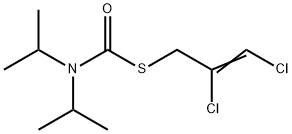디알린산 C화학적 특성, 용도, 생산
화학적 성질
Diallate is a brown liquid.
용도
Diallate is a pesticide used to treat fruits and vegetables. Environmental wastewater pollutant.Environmental toxin on US EPA Toxic Release Inventory list (TRI) list.
일반 설명
Used as an herbicide.
공기와 물의 반응
Thio and dithiocarbamates slowly decompose in aqueous solution to form carbon disulfide and methylamine or other amines. Such decompositions are accelerated by acids.
반응 프로필
DIALLATE is a thiocarbamate ester. Flammable gases are generated by the combination of thiocarbamates and dithiocarbamates with aldehydes, nitrides, and hydrides. Thiocarbamates and dithiocarbamates are incompatible with acids, peroxides, and acid halides.
Safety Profile
Poison by ingestion.
Moderately toxic by skin contact.
Questionable carcinogen with experimental
carcinogenic and tumorigenic data. Mutation
data reported. When heated to
decomposition it emits very toxic fumes of
Cl-, NOx, and SOx. See also
CARBAMATES and ALLYL
COMPOUNDS.
잠재적 노출
A thiocarbamate herbicide. The slow
release of poisonous gases from hydrolysis of many thio
and dithiocarbamates requires the use of respirators during
handling. Poisoning can also occur by ingestion and
absorption through the skin. Diallate is potential danger to
those involved in the manufacture, formulation and applica-
tion of this re-emergence herbicide.
환경귀착
Soil. Soil metabolites include 2,3-dichloroallyl alcohol, 2,3-dichloroallyl mercaptan
(Hartley and Kidd, 1987) and carbon dioxide (Smith, 1988). The formation of the alcohol
occurs via hydrolysis of the ester linkage and transthiolation of the allylic group (Kaufman,
1967). In an agricultural soil, 14CO2 was the only biodegradation identified; however, bound
residue and traces of benzene and water-soluble radioactivity were also detected in large
amounts (Anderson and Domsch, 1980). The reported half-lives in soil range from 2 to 4
weeks to (Smith and Fitzpatrick, 1970) to approximately 30 days (Hartley and Kidd, 1987).
Diallate did not migrate deeper than 5 cm on test field plots (Smith, 1970). In four
microbially-active agricultural soils, the half-life was 4 weeks but in sterilized soil the
half-life was 20 weeks (Anderson and Domsch, 1976).
Plant. In plants, diallate is metabolized and carbon dioxide is released (Hartley and
Kidd, 1987). Diallate undergoes cis/trans isomerization and oxidative cleavage when
irradiated at 300 nm forming 2,3-dichloroacrolein and 2-chloroacrolein as products (Ruzo
and Casida, 1985).
Photolytic. Irradiation of diallate was also conducted in oxygenated chloroform or
water until a 10% conversion was obtained. Products formed included acetaldehyde, 2,3-
dichloroacrolein and trace amounts of 2-chloroacrolein (Ruzo and Casida, 1985).
Chemical/Physical. Emits toxic fumes of chlorine, nitrogen and sulfur oxides when
heated to decomposition (Sax and Lewis, 1987). Though no products were reported, the
calculated hydrolysis half-life at 25°C and pH 7 is 6.6 years (Ellington et al., 1988).
운송 방법
UN2992 Carbamate pesticides, liquid, toxic,
Hazard Class: 6.1; Labels: 6.1-Poisonous materials.
비 호환성
hiocarbamate esters are combustible.
They react violently with powerful oxidizers such as
calcium hypochlorite. Poisonous gases are generated by the
thermal decomposition of thiocarbamate compounds,
including carbon disulfide, oxides of sulfur, oxides of nitro-
gen, hydrogen sulfide, ammonia, and methylamine. Many
materials in this group slowly decompose in aqueous solu-
tion to form carbon disulfide and methylamine or other
amines. Such decompositions are accelerated by acids.
Flammable gases are generated by the combination of
thiocarbamates with aldehydes, nitrides, and hydrides.
Thiocarbamates are incompatible with acids, peroxides, and
acid halides.
폐기물 처리
Land burial is acceptable for
small quantities. Larger quantities can be incinerated
.
In accordance with 40CFR165, follow recommendations
for the disposal of pesticides and pesticide containers. Must
be disposed properly by following package label directions
or by contacting your local or federal environmental control
agency, or by contacting your regional EPA office. Consult
with environmental regulatory agencies for guidance
on acceptable disposal practices. Generators of waste
containing this contaminant (≥100 kg/mo) must conform
with EPA regulations governing storage, transportation,
treatment, and waste disposal.
디알린산 준비 용품 및 원자재
원자재
준비 용품









